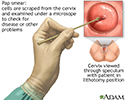Health screenings for women ages 18 to 39
Health maintenance visit - women - ages 18 to 39; Physical exam - women - ages 18 to 39; Yearly exam - women - ages 18 to 39; Checkup - women - ages 18 to 39; Women's health - ages 18 to 39; Preventive care - women - ages 18 to 39You should visit your health care provider from time to time, even if you are healthy. The purpose of these visits is to:
- Screen for medical issues
- Assess your risk for future medical problems
- Encourage a healthy lifestyle
- Update vaccinations and other preventive care services
- Help you get to know your provider in case of an illness
Information
Even if you feel fine, you should still see your provider for regular checkups. These visits can help you avoid problems in the future. For example, the only way to find out if you have high blood pressure is to have it checked regularly. High blood sugar and high cholesterol levels also may not have any symptoms in the early stages. A simple blood test can check for these conditions.
High blood pressure
Blood pressure is a measurement of the force exerted against the walls of your arteries as your heart pumps blood to your body. Hypertension is the ...

High cholesterol
Cholesterol is a fat (also called a lipid) that your body needs to work properly. Too much bad cholesterol in your blood can increase your chance of...

There are specific times when you should see your provider or receive specific health screenings. The US Preventive Services Task Force publishes a list of recommended screenings. Below are screening guidelines for women ages 18 to 39.
BLOOD PRESSURE SCREENING
Your blood pressure should be checked at least once every 3 to 5 years if:
Blood pressure
Blood pressure is a measurement of the force on the walls of your arteries as your heart pumps blood through your body. You can measure your blood pr...

- Your blood pressure is in the normal range (top number less than 120 mm Hg and bottom number less than 80 mm Hg)
- You don't have risk factors for high blood pressure
Ask your provider if you need your blood pressure checked more often if:
- The top number is 120 to 129 mm Hg or the bottom number is 70 to 79 mm Hg
- You have diabetes, heart disease, kidney problems, are overweight, or have certain other health conditions
Heart disease
Coronary heart disease is a narrowing of the blood vessels that supply blood and oxygen to the heart. Coronary heart disease (CHD) is also called co...
 ImageRead Article Now Book Mark Article
ImageRead Article Now Book Mark ArticleKidney problems
Chronic kidney disease is the slow loss of kidney function over time. The main job of the kidneys is to remove wastes and excess water from the body...
 ImageRead Article Now Book Mark Article
ImageRead Article Now Book Mark Article - You have a first-degree relative with high blood pressure
- You are Black
- You had high blood pressure during a pregnancy
If the top number is 130 mm Hg or greater or the bottom number is 80 mm Hg or greater, this is considered stage 1 hypertension. Schedule an appointment with your provider to learn how you can reduce your blood pressure.
Watch for blood pressure screenings in your area. Ask your provider if you can stop in to have your blood pressure checked.
BREAST CANCER SCREENING
- Experts do not agree about the benefits of breast self-exams in finding breast cancer or saving lives. Talk to your provider about what is best for you.
- A screening mammogram is not recommended for most women under age 40.
Your provider may discuss and recommend mammograms, MRI scans, or ultrasounds if you have an increased risk for breast cancer, such as:
- A mother or sister who had breast cancer at a young age (most often starting screening earlier than the age the close relative was diagnosed)
- You carry a high-risk genetic marker
CERVICAL CANCER SCREENING
Cervical cancer screening should start at age 21 years unless your provider advises otherwise.
After the first test:
- Women ages 21 through 29 should have a Pap test every 3 years. Exoprts do not agree on whether HPV testing is recommended for this age group.
Pap test
The Pap test mainly checks for changes that may turn into cervical cancer. Cells scraped from the opening of the cervix are examined under a microsc...
 ImageRead Article Now Book Mark Article
ImageRead Article Now Book Mark Article - Women ages 30 through 65 should be screened with either a Pap test every 3 years or the HPV test every 5 years or both tests every 5 years (called "cotesting").
- Women who have been treated for precancer (cervical dysplasia) should continue to have Pap tests for 20 years after treatment or until age 65, whichever is longer.
- If you have had your uterus and cervix removed (total hysterectomy), and you have not been diagnosed with cervical cancer or precancer (high grade cervical neoplasia), you do not need cervical cancer screening.
Total hysterectomy
Hysterectomy is surgery to remove a woman's womb (uterus). The uterus is a hollow muscular organ that nourishes the developing baby during pregnancy...
 ImageRead Article Now Book Mark Article
ImageRead Article Now Book Mark Article
CHOLESTEROL SCREENING
Cholesterol screening should begin at:
Cholesterol screening
Cholesterol is a soft, wax-like substance found in all parts of the body. Your body needs a little bit of cholesterol to work properly. But too muc...

- Age 45 for women with no known risk factors for coronary heart disease
- Age 20 for women with known risk factors for coronary heart disease
Repeat cholesterol screening should take place:
- Every 5 years for women with normal cholesterol levels
- More often if changes occur in lifestyle (including weight gain and diet)
- More often if you have diabetes, heart disease, kidney problems, or certain other conditions
DIABETES SCREENING
You should be screened for diabetes starting at age 35 and then repeated every 3 years if you have no risk factors for diabetes.
Screening may need to start earlier and be repeated more often if you have other risk factors for diabetes, such as:
Diabetes
Diabetes is a long-term (chronic) disease in which the body cannot regulate the amount of sugar in the blood.

- You have a first degree relative with diabetes.
- You are overweight or have obesity.
- You have high blood pressure, prediabetes, or a history of heart disease.
Screening for diabetes should be done if you are planning to become pregnant and you are overweight and have other risk factors such as high blood pressure.
DENTAL EXAM
- Go to the dentist once or twice every year for an exam and cleaning. Your dentist will evaluate if you need more frequent visits.
EYE EXAM
- Have an eye exam every 5 to 10 years before age 40.
- If you have vision problems, have an eye exam every 2 years or more often if recommended by your provider.
Vision problems
There are many types of eye problems and vision disturbances, such as: Halos Blurred vision (the loss of sharpness of vision and the inability to see...
 ImageRead Article Now Book Mark Article
ImageRead Article Now Book Mark Article - You should have an eye exam that includes an examination of your retina (back of your eye) at least every year if you have diabetes.
IMMUNIZATIONS
Commonly needed vaccines include:
-
Flu shot: get one every year.
Flu
The flu (influenza) is a viral respiratory illness that causes fever, chills, runny nose, body aches, and cough. It spreads easily from person to pe...
 ImageRead Article Now Book Mark Article
ImageRead Article Now Book Mark Article - COVID-19 vaccine: ask your provider what is best for you.
-
Tetanus-diphtheria and acellular pertussis (Tdap) vaccine: have one at or after age 19 as one of your tetanus-diphtheria vaccines if you did not receive it as an adolescent.
Tetanus-diphtheria and acellular pertus...
All content below is taken in its entirety from the Centers for Disease Control (CDC) Tdap Vaccine Information Statement (VIS): www. cdc. gov/vaccine...
 ImageRead Article Now Book Mark Article
ImageRead Article Now Book Mark Article - Tetanus-diphtheria: have a booster (or Tdap) every 10 years.
-
Varicella vaccine: receive 2 doses if you never had chickenpox or the varicella vaccine.
Chickenpox
Chickenpox is a viral infection in which a person develops very itchy blisters all over the body. It was more common in the past. The illness is ra...
 ImageRead Article Now Book Mark Article
ImageRead Article Now Book Mark Article - Hepatitis B vaccine: receive 2, 3, or 4 doses, depending on your exact circumstances.
-
Measles, mumps, and rubella (MMR) vaccine: receive 1 to 2 doses if you are not already immune to MMR. Your provider can tell you if you are immune.
Measles, mumps, and rubella (MMR)
All content below is taken in its entirety from the CDC MMR (Measles, Mumps, & Rubella) Vaccine Information Statement (VIS): cdc. gov/vaccines/hcp/vi...
Read Article Now Book Mark Article
Ask your provider about the human papillomavirus (HPV) vaccine if:
Human papillomavirus (HPV)
All content below is taken in its entirety from the CDC HPV (Human Papillomavirus) Vaccine Information Statement (VIS): www. cdc. gov/vaccines/hcp/vi...

- You have not received the HPV vaccine in the past
- You have not completed the full vaccine series (you should catch up on this shot)
Ask your provider if you should receive other immunizations if you have certain health problems that increase your risk for some diseases such as pneumonia.
INFECTIOUS DISEASE SCREENING
- Women who are sexually active should be screened for chlamydia and gonorrhea up until age 25.
- Women 25 years and older should be screened for chlamydia and gonorrhea if at high risk.
Screening for hepatitis C:
- All adults ages 18 to 79 should get a one-time test for hepatitis C.
Hepatitis C
Hepatitis C is a viral disease that leads to swelling (inflammation) of the liver. Other types of viral hepatitis include:Hepatitis AHepatitis BHepat...
 ImageRead Article Now Book Mark Article
ImageRead Article Now Book Mark Article - Pregnant people should be screened at every pregnancy.
Screening for human immunodeficiency virus (HIV):
- All people ages 15 to 65 should get a one-time test for HIV.
HIV
Human immunodeficiency virus (HIV) is the virus that causes acquired immunodeficiency syndrome (AIDS). When a person becomes infected with HIV, the ...
 ImageRead Article Now Book Mark Article
ImageRead Article Now Book Mark Article
Depending on your lifestyle and medical history, you may also need to be screened for infections such as syphilis and HIV, as well as other infections.
PHYSICAL EXAM
All adults should visit their provider from time to time, even if they are healthy. The purpose of these visits is to:
- Screen for disease
- Assess your risk of future medical problems
- Encourage a healthy lifestyle
- Update your vaccinations and other preventive care services
- Maintain a relationship with a provider in case of an illness
Your height, weight, and BMI should be checked at every exam.
BMI
A good way to decide if your weight is healthy for your height is to figure out your body mass index (BMI). You and your health care provider can us...

During your exam, your provider may ask you about:
-
Depression and anxiety
Depression
Depression may be described as feeling sad, blue, unhappy, miserable, or down in the dumps. Most of us feel this way at one time or another for shor...
 ImageRead Article Now Book Mark Article
ImageRead Article Now Book Mark Article - Diet and exercise
- Alcohol and tobacco use
- Safety issues, such as using seat belts, smoke detectors, and intimate partner violence
- Your medicines and risk for interactions
SKIN SELF-EXAM
Your provider may check your skin for signs of skin cancer, especially if you're at high risk, such as if you:
Skin cancer
Squamous cell skin cancer is the second most common type of cancer in the United States. Other common types of skin cancer are:Basal cell cancerMelan...

- Have had skin cancer before
- Have close relatives with skin cancer
- Have a weakened immune system
OTHER SCREENING
- Talk with your provider about colon cancer screening if you have a strong family history of colon cancer or polyps, or if you have had inflammatory bowel disease or polyps yourself.
- Routine bone density screening of women under 40 is not recommended.
References
Advisory Committee on Immunization Practices. Recommended immunization schedule for adults aged 19 years or older, United States, 2023. www.cdc.gov/vaccines/schedules/hcp/imz/adult.html. Updated April 17, 2023. Accessed July 30, 2023.
American Academy of Ophthalmology website. Clinical statement: comprehensive adult medical eye examination PPP 2020. www.aao.org/education/preferred-practice-pattern/comprehensive-adult-medical-eye-evaluation-ppp. Updated November 2020. Accessed July 30, 2023.
American Cancer Society website. Breast cancer early detection and diagnosis: American Cancer Society recommendations for the early detection of breast cancer. www.cancer.org/cancer/breast-cancer/screening-tests-and-early-detection/american-cancer-society-recommendations-for-the-early-detection-of-breast-cancer.html. Updated January 14, 2022. Accessed July 30, 2023.
American College of Obstetricians and Gynecologists (ACOG) website. FAQ178: Mammography and other screening tests for breast problems. www.acog.org/patient-resources/faqs/gynecologic-problems/mammography-and-other-screening-tests-for-breast-problems. Updated July 2022. Accessed July 30, 2023.
American College of Obstetricians and Gynecologists. FAQ163: Cervical cancer. www.acog.org/patient-resources/faqs/gynecologic-problems/cervical-cancer. Updated April 2021. Accessed July 30, 2023.
American Dental Association website. Your top 9 questions about going to the dentist -- answered! www.mouthhealthy.org/en/dental-care-concerns/questions-about-going-to-the-dentist. Accessed July 30, 2023.
Atkins D, Barton M. The periodic health examination. In: Goldman L, Schafer AI, eds. Goldman-Cecil Medicine. 26th ed. Philadelphia, PA: Elsevier; 2020:chap 12.
Brown HL, Warner JJ, Gianos E, et al; American Heart Association and the American College of Obstetricians and Gynecologists. Promoting risk identification and reduction of cardiovascular disease in women through collaboration with obstetricians and gynecologists: a presidential advisory from the American Heart Association and the American College of Obstetricians and Gynecologists. Circulation. 2018;137(24):e843-e852. PMID: 29748185 pubmed.ncbi.nlm.nih.gov/29748185/.
ElSayed NA, Aleppo G, Aroda VR, American Diabetes Association, et al. Professional Practice Committee. 2. Classification and diagnosis of diabetes: standards of medical care in diabetes-2023. Diabetes Care. 2023;46(Suppl 1):S19-S30. PMID: 36507649. pubmed.ncbi.nlm.nih.gov/36507649/.
Grundy SM, Stone NJ, Bailey AL, et al. 2018 AHA/ACC/AACVPR/AAPA/ABC/ACPM/ADA/AGS/APhA/ASPC/NLA/PCNA Guideline on the management of blood cholesterol: a report of the American College of Cardiology/American Heart Association Task Force on Clinical Practice Guidelines [published correction appears in J Am Coll Cardiol. 2019 Jun 25;73(24):3237-3241]. J Am Coll Cardiol. 2019;73(24):e285-e350. PMID: 30423393 pubmed.ncbi.nlm.nih.gov/30423393/.
Meschia JF, Bushnell C, Boden-Albala B; American Heart Association Stroke Council; et al. Guidelines for the primary prevention of stroke: a statement for healthcare professionals from the American Heart Association/American Stroke Association. Stroke. 2014;45(12):3754-3832. PMID: 25355838 pubmed.ncbi.nlm.nih.gov/25355838/.
Mora S, Libby P, Ridker PM. Primary prevention of cardiovascular disease. In: Libby P, Bonow RO, Mann DL, Tomaselli GF, Bhatt DL, Solomon SD, eds. Braunwald's Heart Disease: A Textbook of Cardiovascular Medicine. 12th ed. Philadelphia, PA: Elsevier; 2022:chap 25.
National Cancer Institute website. Breast cancer screening (PDQ) - health professional version. www.cancer.gov/types/breast/hp/breast-screening-pdq. Updated June 7, 2023. Accessed July 30, 2023.
US Preventive Services Task Force website. A and B recommendations. www.uspreventiveservicestaskforce.org/uspstf/recommendation-topics/uspstf-a-and-b-recommendations. Accessed July 30, 2023.
US Preventive Services Task Force website. Final recommendation statement. Breast cancer: Medication use to reduce risk. www.uspreventiveservicestaskforce.org/uspstf/recommendation/breast-cancer-medications-for-risk-reduction. Updated September 3, 2019. Accessed July 30, 2023.
US Preventive Services Task Force website. Final recommendation statement. Breast cancer: screening. www.uspreventiveservicestaskforce.org/uspstf/recommendation/breast-cancer-screening. Updated January 11, 2016. Accessed July 30, 2023.
US Preventive Services Task Force website. Final recommendation statement. Cervical cancer: screening. www.uspreventiveservicestaskforce.org/uspstf/recommendation/cervical-cancer-screening. Updated August 21, 2018. Accessed July 30, 2023.
US Preventive Services Task Force website. Final recommendation statement. Colorectal cancer: screening. www.uspreventiveservicestaskforce.org/uspstf/recommendation/colorectal-cancer-screening. Updated May 18, 2021. Accessed July 30, 2023.
US Preventive Services Task Force website. Final recommendation statement. Hepatitis C virus infection in adolescents and adults: screening. www.uspreventiveservicestaskforce.org/uspstf/recommendation/hepatitis-c-screening. Published March 2, 2020. Accessed July 30, 2023.
US Preventive Services Task Force website. Final recommendation statement. Human immunodeficiency virus (HIV) infection: screening. www.uspreventiveservicestaskforce.org/uspstf/recommendation/human-immunodeficiency-virus-hiv-infection-screening. Published June 11, 2019. Accessed July 30, 2023.
US Preventive Services Task Force website. Hypertension in adults: screening. www.uspreventiveservicestaskforce.org/uspstf/recommendation/hypertension-in-adults-screening. Published April 27, 2021. Accessed July 30, 2023.
US Preventive Services Task Force website. Final recommendation statement: Lung cancer: screening. www.uspreventiveservicestaskforce.org/uspstf/recommendation/lung-cancer-screening. Updated March 9, 2021. Accessed July 30, 2023.
US Preventive Services Task Force website. Final recommendation statement. Prediabetes and type 2 diabetes: screening. www.uspreventiveservicestaskforce.org/uspstf/recommendation/screening-for-prediabetes-and-type-2-diabetes. Updated August 24, 2021. Accessed July 30, 2023.
US Preventive Services Task Force website. Final recommendation statement. Skin cancer: screening. www.uspreventiveservicestaskforce.org/uspstf/recommendation/skin-cancer-screening. Updated April 18, 2023. Accessed July 30, 2023.
Whelton PK, Carey RM, Mancia G, Kreutz R, Bundy JD, Williams B. Harmonization of the American College of Cardiology/American Heart Association and European Society of Cardiology/European Society of Hypertension Blood Pressure/Hypertension Guidelines: Comparisons, reflections, and recommendations. Circulation. 2022;146:868-877. DOI: 10.1161/CIRCULATIONAHA.121.054602. PMID 35950927. pubmed.ncbi.nlm.nih.gov/35950927/.
-
Pap smear
Animation
-
Pap smear - illustration
A Pap test is a simple, relatively inexpensive procedure that can easily detect cancerous or precancerous conditions.
Pap smear
illustration
Review Date: 8/1/2023
Reviewed By: David C. Dugdale, III, MD, Professor of Medicine, Division of General Medicine, Department of Medicine, University of Washington School of Medicine. Also reviewed by David Zieve, MD, MHA, Medical Director, Brenda Conaway, Editorial Director, and the A.D.A.M. Editorial team. Editorial update 04/18/2023. Internal review and update on 08/01/23.




